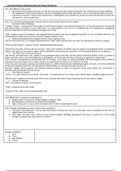A-Level Literature: Revision Guide for Elegy: His Picture
AO1: BIG IDEA(s) of the poem?
● Donne gives his portrait to his lover, so that she can keep it and see what he looks like, if he comes back and looks different.
We experience a fearful side to Donne, as he is in trepidation that his lover will cheat on him or not want him when he comes
back from his travels. It can be seen that Donne is contemplation as to whether his travels are worth this risk that his lover may
not want him, when he gets back.
AO2: Top 5 form/structure/language methods used to communicate meaning to the reader?
1. Semantic Field of Damage
“”weather- beaten”- a dysphemism that makes it sound like the weather is physically damaging him, to the point where it is harming him
and being violent, but really it’s more likely that it is a heat stroke or sun burn he is suffering from, the dysphemism exaggerates
Donne’s belief that he will be emotionally damaged from his trip
“rash”- creates a sense of immediacy, and suggests that the weather may have a negative long effect on him, most likely referring to the
fact that the time apart from his lover will have a negative impact on him
2. Rhetorical Questions {he imagines what his lover is going to say}
“Do his hurts reach me?”- an imagined dismissal of the “rivals” {which are the other men that may approach her whilst he’s away}
“doth my worth decay?”- a sense of doubt, emotional blackmail perhaps
“should now love less, what he did love to see?”- sets up the question of whether they are going to be superficial lovers or something
higher in the realms of neo-platonic ideals, with the alliteration emphasizing the importance of this question that Donne is setting up
3. The Title, Form, Tone and Structure
“His Picture”- the determiner “his” creates a more possessive edge to the title, and the picture could be a portrait, which is symbolic of
status of wealth, and is more meaningful than a photograph, as it is precise and time consuming, as appose to a photograph
Form- Donne is subverting the conventional form of an elegy, as an elegy is usually permeated with sad thoughts, and is written to
express sorrow for someone who is dead, however we clearly know that his lover or Donne is not dead
Tone- this poem has quite a musing and realistic tenor to it, whilst simultaneously intertwining thoughts of doubt, as Donne is reflective
of what he is getting himself into, and debating to himself whether he should go through with it or not
Structure- regular rhyme scheme, with frequent rhyming couplets to make his argument sound more certain and constructed, to
perhaps cover his element of doubt he has
4. Neo-Platonic Imagery
“Thine, in my heart, where my soul dwells, shall dwell.”- he wants there to be a living in each-other’s hearts, repetition emphasizes this
“twill be more”- expresses that their souls will be more valuable when they’re dead, exploring the real neo-platonic ideals
5. Conceit of Weaning
“milk”- connotations of purity, and innocence
“tough”- juxtaposes the purity image
“to feed on that”- quite a needy and demanding verb
AO3: RELEVANT contextual considerations?
● Written before he joined Sir Walter Raleigh to Cadiz in 1596
● He addresses a previous lover rather than Anne More
● Age of Discovery- he was a keen enthusiast when it came to exploring the world
AO5: Possible interpretations and/or useful critical quotations?
● Feminism- “thou shalt say” it can be seen that Donne is treating the lover as a commodity, and is controlling her like she’s an
object rather than a person
● John Wall- “his hope, never without a move towards despair" definitely applicable to this poem, as when he’s in his musing
thought, he always has doubt about his actions
Possible THEMES?
● Love
● Time
● Neo-Platonic
● Decay





